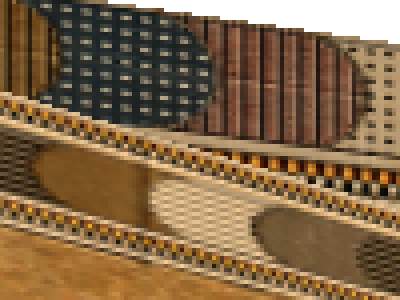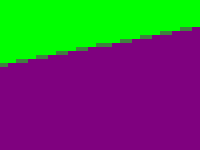NVIDIA GeForce3 Investigation: What NVIDIA didn't tell us
by Kert Chian on May 15, 2001 1:18 AM EST- Posted in
- GPUs
Anti-aliasing
The key difference between GeForce3 and GeForce2 anti-aliasing is that the
former is capable of multi-sampling while the latter resorts to supersampling.
GeForce2 renders the screen image at a much higher resolution than the current
display mode, and then scales and filters the image to the final resolution
before it is sent to the display. On the other hand, GeForce3 renders the same
pixel data into multiple locations offset by a small amount (less than a pixel
in size). These subpixels are generated at the end of the pixel processing stage,
just before framebuffer write.
GeForce3 consumes the same texture bandwidth even with anti-aliasing turned
on. Texture resolution is the same as without multi-sampling. In addition, the
same quantity of textures are used. There is, therefore, no improvement in texture
quality with anti-aliasing turned on. Quincunx multi-sampling merits further
elaboration. It generates two subpixels, as in 2-sample multi-sampling. It differs
from 2-sample multi-sampling in that it additionally samples from 3 neighbouring
pixels to compute the final pixel color. As can be imagined, this reduces texture
fidelity. A high frequency texture shows this to good effect (figures 10 to
11).

Figure 10: aliased image (enlarged 4x with nearest neighbour sampling)

Figure 11: Quincunx anti-aliasing (enlarged 4x with nearest neighbour sampling)
Contrast this with GeForce2 supersampling. Since the scene is rendered at a
higher resolution, a greater quantity of texture data is needed for the same
degree of anti-aliasing. In addition, textures of a higher resolution and clarity
are also used. The negative aspect is that texture bandwidth is increased by
a multiple of the degree of anti-aliasing. On a positive note, the anti-aliased
scene has sharper texture detail.
The following observations are made with regards to quality of anti-aliasing
at the edges. For the same degree of anti-aliasing, differences at the edges
between GeForce3 and GeForce2, if any, are not noticeable. 2-sample multi-sampling
generates far too few subpixels for high quality anti-aliasing. Quincunx multi-sampling
is very good below approximately 15 degrees from the vertical or horizontal,
better than 4-sample multi-sampling (figure 12). However, if all angles are
taken into account, the overall best solution still belongs to 4-sample multi-sampling.
 |
 |
 |
| 2-sample multi-sampling | Quincunx multi-sampling | 4-sample multi-sampling |
 |
 |
 |
| 2-sample multisampling | Quincunx multi-sampling | 4-sample multi-sampling |
Figure 13: Anti-aliasing at 40 degrees










0 Comments
View All Comments